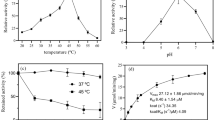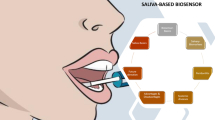Abstract
Objectives
hCAP18/LL-37 is an endogenous antibiotic having a role in innate immunity. The aim of the present study was to evaluate serum and gingival crevicular fluid (GCF) hCAP18/LL-37 levels in patients with generalized aggressive periodontitis (G-AgP).
Materials and methods
Twenty-six G-AgP patients, 24 gingivitis patients, and 25 healthy subjects were included in this study. Periodontal parameters including probing depth, clinical attachment level, plaque index, and papilla bleeding index were recorded. GCF and serum hCAP18/LL-37 levels were analyzed by enzyme-linked immunosorbent assay.
Results
GCF hCAP18/LL-37 level was significantly higher in G-AgP compared to others (p = 0.038, p < 0.001). Gingivitis patients had significantly higher GCF hCAP18/LL-37 levels than controls (p < 0.001). No significant differences were observed in serum hCAP18/LL-37 levels among the study groups (p = 0.524). While there were positive correlations between GCF hCAP18/LL-37 levels and periodontal parameters of sampling sites (p < 0.005), no significant correlation was observed between serum hCAP18/LL-37 levels and whole-mouth periodontal parameters (p > 0.05).
Conclusion
Increased levels of GCF hCAP18/LL-37 in G-AgP might show that it is abundantly expressed in the presence of periodontal tissue destruction. Serum hCAP18/LL-37 levels do not seem to be related with the presence of G-AgP.
Clinical relevance
hCAP18/LL-37 antimicrobial peptide might be associated with periodontal tissue destruction in the presence of aggressive periodontitis.
Similar content being viewed by others
References
Tonetti MS, Mombelli A (1999) Early-onset periodontitis. Ann Periodontol 4:39–53. doi:10.1902/annals.1999.4.1.39
Meng H, Xu L, Li Q, Han J, Zhao Y (2007) Determinants of host susceptibility in aggressive periodontitis. Periodontol 2000 43:133–159. doi:10.1111/j.1600-0757.2006.00204.x
Kulkarni C, Kinane DF (2014) Host response in aggressive periodontitis. Periodontol 2000(65):79–91. doi:10.1111/prd.12017
Kornman KS, di Giovine FS (1998) Genetic variations in cytokine expression: a risk factor for severity of adult periodontitis. Ann Periodontol 3:327–338. doi:10.1902/annals.1998.3.1.327
Shapira L, Soskolne WA, Sela MN, Offenbacher S, Barak V (1994) The secretion of PGE2, IL-1 beta, IL-6, and TNF alpha by adherent mononuclear cells from early onset periodontitis patients. J Periodontol 65:139–146. doi:10.1902/jop.1994.65.2.139
Emingil G, Cinarcik S, Baylas H, Coker I, Huseyinov A (2001) Levels of leukotriene B4 in gingival crevicular fluid and gingival tissue in specific periodontal diseases. J Periodontol 72:1025–1031. doi:10.1902/jop.2001.72.8.1025
Eick S, Pfister W, Sigusch B, Straube E (2000) Phagocytosis of periodontopathogenic bacteria by crevicular granulocytes is depressed in progressive periodontitis. Infection 28:301–304
Liu RK, Cao CF, Meng HX, Gao Y (2001) Polymorphonuclear neutrophils and their mediators in gingival tissues from generalized aggressive periodontitis. J Periodontol 72:1545–1553. doi:10.1902/jop.2001.72.11.1545
Kinane DF, Hart TC (2003) Genes and gene polymorphisms associated with periodontal disease. Crit Rev Oral Biol Med: Off Publ Am Assoc Oral Biol 14:430–449
Loos BG, John RP, Laine ML (2005) Identification of genetic risk factors for periodontitis and possible mechanisms of action. J Clin Periodontol 32(Suppl 6):159–179. doi:10.1111/j.1600-051X.2005.00806.x
Del Fabbro M, Francetti L, Pizzoni L, Weinstein RL (2000) Congenital neutrophil defects and periodontal diseases. Minerva Stomatol 49:293–311
Lentsch AB, Ward PA (2000) Regulation of inflammatory vascular damage. J Pathol 190:343–348. doi:10.1002/(SICI)1096-9896(200002)190:3<343::AID-PATH522>3.0.CO;2-M
Freire MO, Van Dyke TE (2013) Natural resolution of inflammation. Periodontol 2000(63):149–164. doi:10.1111/prd.12034
Bals R, Wilson JM (2003) Cathelicidins–a family of multifunctional antimicrobial peptides. Cell Mol Life Sci: CMLS 60:711–720
Dale BA, Fredericks LP (2005) Antimicrobial peptides in the oral environment: expression and function in health and disease. Curr Issues Mol Biol 7:119–133
Dale BA, Kimball JR, Krisanaprakornkit S, Roberts F, Robinovitch M, O’Neal R, Valore EV, Ganz T, Anderson GM, Weinberg A (2001) Localized antimicrobial peptide expression in human gingiva. J Periodontal Res 36:285–294
Turkoglu O, Kandiloglu G, Berdeli A, Emingil G, Atilla G (2011) Antimicrobial peptide hCAP-18/LL-37 protein and mRNA expressions in different periodontal diseases. Oral Dis 17:60–67. doi:10.1111/j.1601-0825.2010.01704.x
Yilmaz D, Guncu GN, Kononen E, Baris E, Caglayan F, Gursoy UK (2015) Overexpressions of hBD-2, hBD-3, and hCAP18/LL-37 in gingiva of diabetics with periodontitis. Immunobiology 220:1219–1226. doi:10.1016/j.imbio.2015.06.013
Sorensen OE, Follin P, Johnsen AH, Calafat J, Tjabringa GS, Hiemstra PS, Borregaard N (2001) Human cathelicidin, hCAP-18, is processed to the antimicrobial peptide LL-37 by extracellular cleavage with proteinase 3. Blood 97:3951–3959
Miyasaki KT, Wilson ME, Brunetti AJ, Genco RJ (1986) Oxidative and nonoxidative killing of Actinobacillus actinomycetemcomitans by human neutrophils. Infect Immun 53:154–160
Ji S, Hyun J, Park E, Lee BL, Kim KK, Choi Y (2007) Susceptibility of various oral bacteria to antimicrobial peptides and to phagocytosis by neutrophils. J Periodontal Res 42:410–419. doi:10.1111/j.1600-0765.2006.00962.x
Tanaka D, Miyasaki KT, Lehrer RI (2000) Sensitivity of Actinobacillus actinomycetemcomitans and Capnocytophaga spp. to the bactericidal action of LL-37: a cathelicidin found in human leukocytes and epithelium. Oral Microbiol Immunol 15:226–231
de Haar SF, Hiemstra PS, van Steenbergen MT, Everts V, Beertsen W (2006) Role of polymorphonuclear leukocyte-derived serine proteinases in defense against Actinobacillus actinomycetemcomitans. Infect Immun 74:5284–5291. doi:10.1128/IAI.02016-05
Sol A, Ginesin O, Chaushu S, Karra L, Coppenhagen-Glazer S, Ginsburg I, Bachrach G (2013) LL-37 opsonizes and inhibits biofilm formation of Aggregatibacter actinomycetemcomitans at subbactericidal concentrations. Infect Immun 81:3577–3585. doi:10.1128/IAI.01288-12
Bedran TB, Mayer MP, Spolidorio DP, Grenier D (2014) Synergistic anti-inflammatory activity of the antimicrobial peptides human beta-defensin-3 (hBD-3) and cathelicidin (LL-37) in a three-dimensional co-culture model of gingival epithelial cells and fibroblasts. PLoS One 9:e106766. doi:10.1371/journal.pone.0106766
Hoffmann MH, Bruns H, Backdahl L, Neregard P, Niederreiter B, Herrmann M, Catrina AI, Agerberth B, Holmdahl R (2013) The cathelicidins LL-37 and rCRAMP are associated with pathogenic events of arthritis in humans and rats. Ann Rheum Dis 72:1239–1248. doi:10.1136/annrheumdis-2012-202218
Kahlenberg JM, Kaplan MJ (2013) Little peptide, big effects: the role of LL-37 in inflammation and autoimmune disease. J Immunol 191:4895–4901. doi:10.4049/jimmunol.1302005
Hwang YJ, Jung HJ, Kim MJ, Roh NK, Jung JW, Lee YW, Choe YB, Ahn KJ (2014) Serum levels of LL-37 and inflammatory cytokines in plaque and guttate psoriasis. Mediat Inflamm 2014:268257. doi:10.1155/2014/268257
Eick S, Puklo M, Adamowicz K, Kantyka T, Hiemstra P, Stennicke H, Guentsch A, Schacher B, Eickholz P, Potempa J (2014) Lack of cathelicidin processing in Papillon–Lefevre syndrome patients reveals essential role of LL-37 in periodontal homeostasis. Orphanet J Rare Dis 9:148. doi:10.1186/s13023-014-0148-y
Putsep K, Carlsson G, Boman HG, Andersson M (2002) Deficiency of antibacterial peptides in patients with morbus Kostmann: an observation study. Lancet 360:1144–1149. doi:10.1016/S0140-6736(02)11201-3
Loos BG, Craandijk J, Hoek FJ, Wertheim-van Dillen PM, van der Velden U (2000) Elevation of systemic markers related to cardiovascular diseases in the peripheral blood of periodontitis patients. J Periodontol 71:1528–1534. doi:10.1902/jop.2000.71.10.1528
Amar S, Gokce N, Morgan S, Loukideli M, Van Dyke TE, Vita JA (2003) Periodontal disease is associated with brachial artery endothelial dysfunction and systemic inflammation. Arterioscler Thromb Vasc Biol 23:1245–1249. doi:10.1161/01.ATV.0000078603.90302.4A
D’Aiuto F, Parkar M, Andreou G, Suvan J, Brett PM, Ready D, Tonetti MS (2004) Periodontitis and systemic inflammation: control of the local infection is associated with a reduction in serum inflammatory markers. J Dent Res 83:156–160
Sanchez-Hernandez PE, Zamora-Perez AL, Fuentes-Lerma M, Robles-Gomez C, Mariaud-Schmidt RP, Guerrero-Velazquez C (2011) IL-12 and IL-18 levels in serum and gingival tissue in aggressive and chronic periodontitis. Oral Dis 17:522–529. doi:10.1111/j.1601-0825.2011.01798.x
Wohlfeil M, Scharf S, Siegelin Y, Schacher B, Oremek GM, Sauer-Eppel H, Schubert R, Eickholz P (2012) Increased systemic elastase and C-reactive protein in aggressive periodontitis (CLOI-D-00160R2). Clin Oral Investig 16:1199–1207. doi:10.1007/s00784-011-0627-7
Leino L, Hurttia HM, Sorvajarvi K, Sewon LA (1994) Increased respiratory burst activity is associated with normal expression of IgG-Fc-receptors and complement receptors in peripheral neutrophils from patients with juvenile periodontitis. J Periodontal Res 29:179–184
Shapira L, Borinski R, Sela MN, Soskolne A (1991) Superoxide formation and chemiluminescence of peripheral polymorphonuclear leukocytes in rapidly progressive periodontitis patients. J Clin Periodontol 18:44–48
Quigley GA, Hein JW (1962) Comparative cleansing efficiency of manual and power brushing. J Am Dent Assoc 65:26–29
Ainamo J, Bay I (1975) Problems and proposals for recording gingivitis and plaque. Int Dent J 25:229–235
Saxer UP and Muhlemann HR (1975) [Motivation and education]. Schweizerische Monatsschrift fur Zahnheilkunde = Revue mensuelle suisse d’odonto-stomatologie/SSO 85:905–19
Armitage GC (1999) Development of a classification system for periodontal diseases and conditions. Ann Periodontol 4:1–6. doi:10.1902/annals.1999.4.1.1
Lamster IB, Hartley LJ, Oshrain RL, Gordon JM (1985) Evaluation and modification of spectrophotometric procedures for analysis of lactate dehydrogenase, beta-glucuronidase and arylsulphatase in human gingival crevicular fluid collected with filter-paper strips. Arch Oral Biol 30:235–242
Chapple IL, Landini G, Griffiths GS, Patel NC, Ward RS (1999) Calibration of the Periotron 8000 and 6000 by polynomial regression. J Periodontal Res 34:79–86
Puklo M, Guentsch A, Hiemstra PS, Eick S, Potempa J (2008) Analysis of neutrophil-derived antimicrobial peptides in gingival crevicular fluid suggests importance of cathelicidin LL-37 in the innate immune response against periodontogenic bacteria. Oral Microbiol Immunol 23:328–335. doi:10.1111/j.1399-302X.2008.00433.x
Turkoglu O, Emingil G, Kutukculer N, Atilla G (2009) Gingival crevicular fluid levels of cathelicidin LL-37 and interleukin-18 in patients with chronic periodontitis. J Periodontol 80:969–976. doi:10.1902/jop.2009.080532
Hosokawa I, Hosokawa Y, Komatsuzawa H, Goncalves RB, Karimbux N, Napimoga MH, Seki M, Ouhara K, Sugai M, Taubman MA, Kawai T (2006) Innate immune peptide LL-37 displays distinct expression pattern from beta-defensins in inflamed gingival tissue. Clin Exp Immunol 146:218–225. doi:10.1111/j.1365-2249.2006.03200.x
Mariano FS, Campanelli AP, Nociti Jr FH, Mattos-Graner RO and Goncalves RB (2012) Antimicrobial peptides and nitric oxide production by neutrophils from periodontitis subjects. Brazilian journal of medical and biological research = Revista brasileira de pesquisas medicas e biologicas/Sociedade Brasileira de Biofisica [et al] 45:1017–24
Author information
Authors and Affiliations
Corresponding author
Ethics declarations
Conflict of interest
The authors declare that they have no conflict of interest.
Funding
This study was supported by a grant from Ege University Research Foundation and from the authors themselves.
Ethical approval
All procedures performed in studies involving human participants were in accordance with the ethical standards of Ethics Committee of the Ege University Izmir, Turkey (#14–9.1/29), and with the 1964 Helsinki declaration and its later amendments or comparable ethical standards.
Informed consent
Informed consent was obtained from all individual participants included in the study.
Rights and permissions
About this article
Cite this article
Turkoglu, O., Emingil, G., Eren, G. et al. Gingival crevicular fluid and serum hCAP18/LL-37 levels in generalized aggressive periodontitis. Clin Oral Invest 21, 763–769 (2017). https://doi.org/10.1007/s00784-016-1834-z
Received:
Accepted:
Published:
Issue Date:
DOI: https://doi.org/10.1007/s00784-016-1834-z




